Henri
Matisse
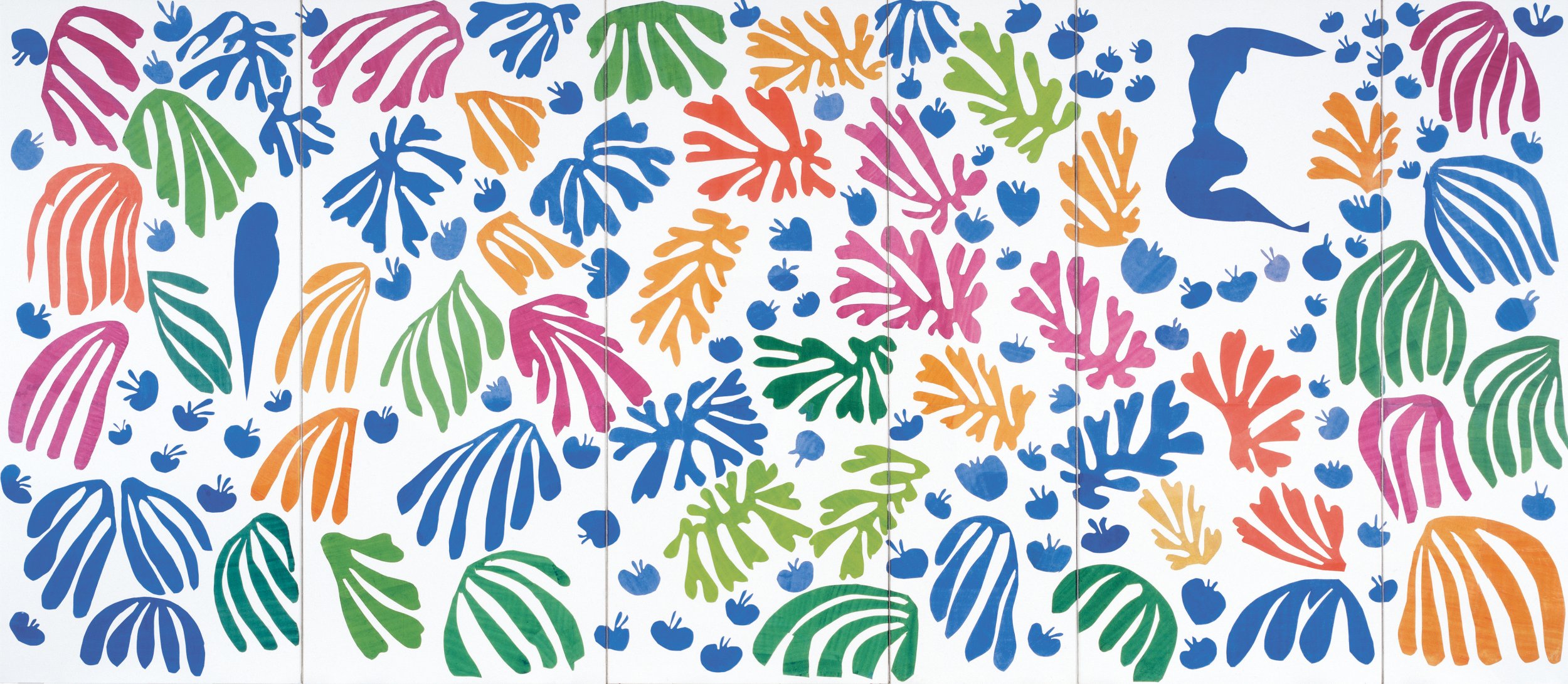
early life
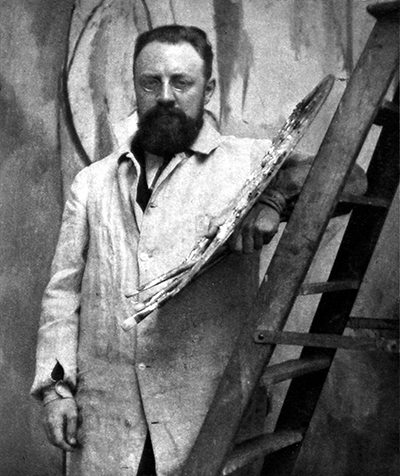

Matisse was born in Le Cateau-Cambrésis, in the Nord department in Northern France, the oldest son of a wealthy grain merchant. He grew up in Bohain-en-Vermandois, Picardie, France. In 1887, he went to Paris to study law, working as a court administrator in Le Cateau-Cambrésis after gaining his qualification. He first started to paint in 1889, after his mother brought him art supplies during a period of convalescence following an attack of appendicitis. He discovered "a kind of paradise" as he later described it,[9] and decided to become an artist, deeply disappointing his father.
In 1891, he returned to Paris to study art at the Académie Julian and became a student of William-Adolphe Bouguereau and Gustave Moreau. Initially he painted still lifes and landscapes in a traditional style, at which he achieved reasonable proficiency. Matisse was influenced by the works of earlier masters such as Jean-Baptiste-Siméon Chardin, Nicolas Poussin, and Antoine Watteau, as well as by modern artists, such as Édouard Manet, and by Japanese art. Chardin was one of the painters Matisse most admired; as an art student he made copies of four of Chardin's paintings in the Louvre.
In 1896, Matisse, an unknown art student at the time, visited the Australian painter John Russell on the island Belle Île off the coast of Brittany. Russell introduced him to Impressionism and to the work of Vincent van Gogh—who had been a friend of Russell—and gave him a Van Gogh drawing. Matisse's style changed completely; abandoning his earth-coloured palette for bright colours. He later said "Russell was my teacher, and Russell explained colour theory to me." The same year, Matisse exhibited five paintings in the salon of the Société Nationale des Beaux-Arts, two of which were purchased by the state.
With the model Caroline Joblau, he had a daughter, Marguerite, born in 1894. In 1898, he married Amélie Noellie Parayre; the two raised Marguerite together and had two sons, Jean (born 1899) and Pierre (born 1900). Marguerite and Amélie often served as models for Matisse.
In 1898, on the advice of Camille Pissarro, he went to London to study the paintings of J. M. W. Turner and then went on a trip to Corsica. Upon his return to Paris in February 1899, he worked beside Albert Marquet and met André Derain, Jean Puy, and Jules Flandrin. Matisse immersed himself in the work of others and went into debt from buying work from painters he admired. The work he hung and displayed in his home included a plaster bust by Rodin, a painting by Gauguin, a drawing by van Gogh, and Cézanne's Three Bathers. In Cézanne's sense of pictorial structure and colour, Matisse found his main inspiration.
Many of Matisse's paintings from 1898 to 1901 make use of a Divisionist technique he adopted after reading Paul Signac's essay, "D'Eugène Delacroix au Néo-impressionisme". His paintings of 1902–03, a period of material hardship for the artist, are comparatively somber and reveal a preoccupation with form. Having made his first attempt at sculpture, a copy after Antoine-Louis Barye, in 1899, he devoted much of his energy to working in clay, completing The Slave in 1903.
early painting
- <
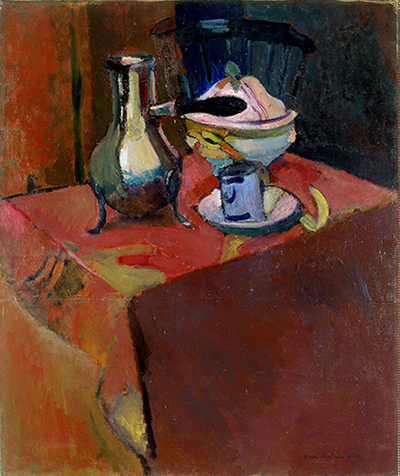
Crockery on a Table
1900
Hermitage Museum
St. Petersburg, Russia 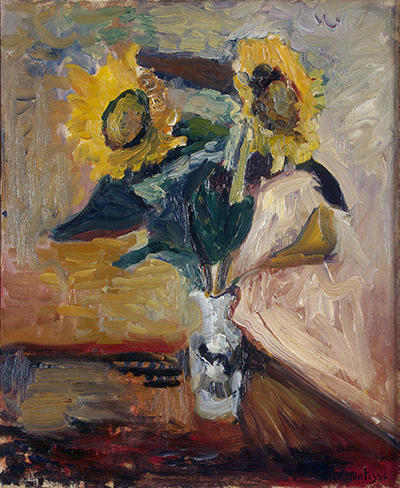
Vase of Sunflowers
1898
Hermitage Museum
St. Petersburg, Russia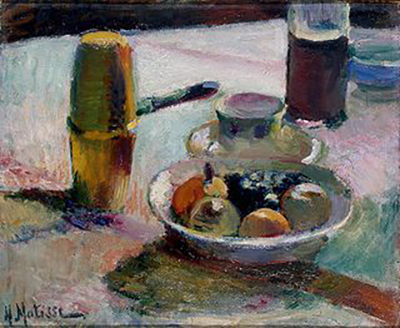
Fruit and Coffepoy
1898
Hermitage Museum
St. Petersburg, Russia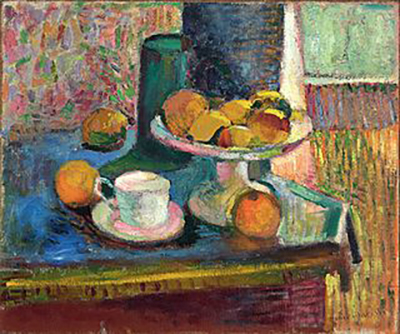
Still Life with Compote, Apples and Oranges
1899
Baltimore Museum of Art
Balimore, United Sates of America
iconic works
1911
Museum of Modern Art
New York City, United States of America
1910
Hermitage Museum
St. Petersburg, Russia
1904
Musuem of Fine Arts
Boston, United Sates of America
1908
St. Louis Art Museum
St. Louis, United Sates of America
time in Paris
Around April 1906, he met Pablo Picasso, who was 11 years younger than Matisse. The two became lifelong friends as well as rivals and are often compared. One key difference between them is that Matisse drew and painted from nature, while Picasso was more inclined to work from imagination. The subjects painted most frequently by both artists were women and still lifes, with Matisse more likely to place his figures in fully realised interiors. Matisse and Picasso were first brought together at the Paris salon of Gertrude Stein with her companion Alice B. Toklas. During the first decade of the twentieth century, the Americans in Paris—Gertrude Stein, her brothers Leo Stein, Michael Stein, and Michael’s wife Sarah—were important collectors and supporters of Matisse’s paintings. In addition, Gertrude Stein’s two American friends from Baltimore, the Cone sisters Claribel and Etta, became major patrons of Matisse and Picasso, collecting hundreds of their paintings and drawings. The Cone collection is now exhibited in the Baltimore Museum of Art.
While numerous artists visited the Stein salon, many of these artists were not represented among the paintings on the walls at 27 rue de Fleurus. Where the works of Renoir, Cézanne, Matisse, and Picasso dominated Leo and Gertrude Stein’s collection, Sarah Stein’s collection particularly emphasised Matisse.
Contemporaries of Leo and Gertrude Stein, Matisse and Picasso became part of their social circle and routinely joined the gatherings that took place on Saturday evenings at 27 rue de Fleurus. Gertrude attributed the beginnings of the Saturday evening salons to Matisse, remarking:
“More and more frequently, people began visiting to see the Matisse paintings—and the Cézannes: Matisse brought people, everybody brought somebody, and they came at any time and it began to be a nuisance, and it was in this way that Saturday evenings began.”
Among Pablo Picasso’s acquaintances who also frequented the Saturday evenings were Fernande Olivier (Picasso’s mistress), Georges Braque, André Derain, the poets Max Jacob and Guillaume Apollinaire, Marie Laurencin (Apollinaire’s mistress and an artist in her own right), and Henri Rousseau.
His friends organized and financed the Académie Matisse in Paris, a private and non-commercial school in which Matisse instructed young artists. It operated from 1907 until 1911. The initiative for the academy came from the Steins and the Dômiers, with the involvement of Hans Purrmann, Patrick Henry Bruce, and Sarah Stein.
final years
Diagnosed with abdominal cancer in 1941, Matisse underwent surgery that left him chair- and bedbound. Painting and sculpture had become physical challenges, so he turned to a new type of medium. With the help of his assistants, he began creating cut paper collages, or decoupage. He would cut sheets of paper, pre-painted with gouache by his assistants, into shapes of varying colours and sizes, and arrange them to form lively compositions. Initially, these pieces were modest in size, but eventually transformed into murals or room-sized works. The result was a distinct and dimensional complexity—an art form that was not quite painting, but not quite sculpture.
Although the paper cut-out was Matisse’s major medium in the final decade of his life, his first recorded use of the technique was in 1919 during the design of decor for the Le chant du rossignol, an opera composed by Igor Stravinsky. Albert C. Barnes arranged for cardboard templates to be made of the unusual dimensions of the walls onto which Matisse, in his studio in Nice, fixed the composition of painted paper shapes. Another group of cut-outs were made between 1937 and 1938, while Matisse was working on the stage sets and costumes for Sergei Diaghilev’s Ballets Russes. However, it was only after his operation that, bedridden, Matisse began to develop the cut-out technique as its own form, rather than its prior utilitarian origin.
He moved to the hilltop of Vence, France in 1943, where he produced his first major cut-out project for his artist’s book titled Jazz. However, these cut-outs were conceived as designs for stencil prints to be looked at in the book, rather than as independent pictorial works. At this point, Matisse still thought of the cut-outs as separate from his principal art form. His new understanding of this medium unfolds with the 1946 introduction for Jazz. After summarizing his career, Matisse refers to the possibilities the cut-out technique offers, insisting “An artist must never be a prisoner of himself, prisoner of a style, prisoner of a reputation, prisoner of success…”
The number of independently conceived cut-outs steadily increased following Jazz, and eventually led to the creation of mural-size works, such as Oceania the Sky and Oceania the Sea of 1946. Under Matisse’s direction, Lydia Delectorskaya, his studio assistant, loosely pinned the silhouettes of birds, fish, and marine vegetation directly onto the walls of the room. The two Oceania pieces, his first cut-outs of this scale, evoked a trip to Tahiti he made years before.
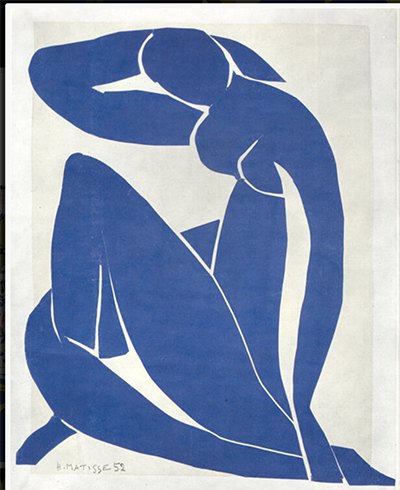
1952
Pompidou Center
Paris, France
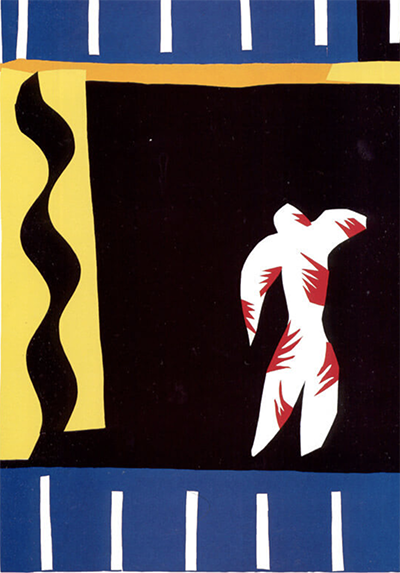
1947
Museum of Modern Art
New York City, United States of America

1943